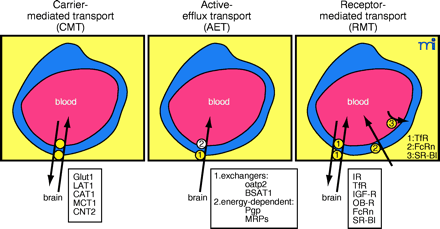
- Institution: Stanford Univ Med Ctr Lane Med Lib/Periodical Dept/Rm L109
- Sign In as Member / Individual
BLOOD-BRAIN BARRIER DRUG TARGETING: THE FUTURE OF BRAIN DRUG DEVELOPMENT

BBB transport systems. Processes involved in ferrying molecules across the BBB include carrier-mediated transport (CMT), active efflux transport (AET), and receptor-mediated transport (RMT). Examples of CMT systems include the GLUT1 glucose transporter, the LAT1 large neutral amino-acid transporter, the CAT1 cationic amino-acid transporter, the MCT1 monocarboxylic acid or lactate transporter, and the CNT2 adenosine transporter. AET, in the brain-to-blood direction, involves the sequential action of an energy-dependent transporter and an energy-independent exchanger at opposite poles of the capillary endothelium. Examples of the energy-dependent systems include P-glycoprotein (Pgp) and the multidrug resistance proteins (MRPs). Examples of the sodium-independent exchangers include organic anion-transporting polypeptide type 2 (oatp2) and BBB-specific anion transporter type 1 (BSAT1), also known as oatp14. The BBB RMT systems include the insulin receptor (IR), the transferrin receptor (TfR), the insulin-like growth factor receptor (IGF-R), the leptin receptor (OB-R), the neonatal Fc receptor (FcRn), or the type BI scavenger receptor (SR-BI). The BBB TfR is located on both luminal and abluminal membranes and mediates the bi-directional transport of transferrin across the BBB. The FcRn is selectively localized on the abluminal membrane and mediates the asymmetric efflux of immunoglobulin G (IgG) molecules from brain to blood. The SR-BI is selectively localized on the luminal membrane of the capillary endothelium and mediates the endocytosis of modified lipoproteins from blood into the brain capillary endothelial compartment, without significant transcytosis through the endothelial barrier.


